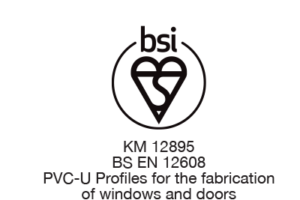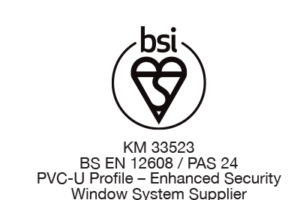








Industry quality standards achieved by the window or door system.
Profile that extends frame.
Alternative to steel. Negligible corrosion (it is non ferritic), lighter but one third the strength of steel.
Not a main frame profile example: cill, coupling.
An injection moulded plastic part that clips into the rebate of the frame and acts against the action of the locking mechanism.
Standards laid down by the Government that must be met within the building construction industry.
Arched shape window with curved semi-circular head frame.
Finishing trim normally around frame perimeter.
Gas that is used in sealed glass units to improve the thermal resistance, argon is a better insulator than air.
Low ferritic grade stainless steel that has high corrosion resistance.
Low ferritic grade stainless steel hinges that have high corrosion resistance.
British Board of Agrement – organisation that assesses and certifies products and manufacturing of said products.
British Fenestration Rating Council – body that accredits window thermal performance – refer WERs.
The drive plate that is situated behind the face plate of a window or door lock.
Refers to tilt-turn hardware: gearing rod on the hinged side of the sash.
The datum measurement from the spindle centre of a lock to the underside of the face plate.
Profile that links bay pole to window frame.
Profile (tube) that covers bay pole.
Round steel or aluminium pole that inserts (reinforces) in bay cover.
Square steel or aluminium pole that inserts (reinforces) corner post.
Square profile that covers bay post.
Also known as bay adaptor – ref bay post cover.
PVC-U finishing trim that covers bay pole assembly.
Angled segmented window that projects from the façade of the building, made from 3 or more coupled frames.
Detail that glazing bead clips into.
The block used to support the bead during cutting.
Door system where the door leaves concertina or stack to form an opening. From 2 leaves to 7 leaves.
Bottom horizontal member of an opener.
Refers to tilt-turn hardware: gearing rod on the bottom handle side of the sash.
Curved window that projects from the façade of the building, normally multi-faceted.
Profile that attaches to a window outer frame to accept finishing trims. Normally closes a cavity left by the removal of a vertical sash window.
British Plastic Federation – trade association for the UK plastics industry.
A wire or moulded component that retains a cavity closer between the brick courses.
AKA woolpile seal. Used in situations where the interface frame slides. Typically patio door sashes.
British Standard – see Kitemark.
British Standard: code of practice for glazing for buildings.
British Standard for performance of windows and doors. Includes Part 1: Classification for weathertightness and guidance on selection and specification & Part 2: performance of windows. Specification for operation and strength characteristics.
British Standard for loading for buildings. Includes Part 1: Code of practice for dead and imposed loads, Part 2: Code of practice for wind loads & Part 3: code of practice for imposed roof loads
British Standard (Kitemark) for PVC-U white windows.
British Standard for windows, doors and rooflights. Includes Part 1: Design for safety in use and during cleaning of windows & Part 4: Code of practice for the survey and installation of windows and external doorsets.
British Standard (Kitemark) for PVC-U white window and door profiles.
Environmental management system.
Health & Safety management system.
Quality management system.
British standards institute – government authority that sets manufacturing standards for industry.
Scheme to a standard (e.g. BSI EN ISO 9000:2000), that continually surveys and assesses the design, development, manufacture and supply of products.
Standards laid down by the Government that must be met within the building construction industry.
Fitted to patio doors to cushion the opening motion of the sliding sash when it is fully open.
Method of breaking in to a door lock cylinder.
Normally a door hinge that seats on the edge of the door leaf.
Where two frame members are joined together in line.
Refers to the impact stabilizer in PVC-U. Czo offers an alternative to lead which was outlawed in 2010.
The main opening part of the window that is supported by hinges/slides/or balances.
Side hung opener.
Window where the sashes open out.
Seal/sealing the window frame by closing the gap around the frame with a flexible sealant (see sealant).
AKA sealant gun: the tool that holds the sealant for its application.
A subframe used in new build that provides a building template for windows and also closes the cavity between inner and outer blockwork – brickwork leaves
Composite door system with 70mm outer frame.
The hollow portion of the frame profile created by webs.
Refers to the chamfered detail on the main profiles: QC, Optima
Angled profile that projects externally from the window at its base, that deflects rain.
Profile that covers/finishes the bottom reveal area behind the window (normally forms a shelf).
Block placed in the cill to transfer the load through the cill on Load-bearing bays/conservatories.
Bottom horizontal member of the outer frame.
An injection-moulded plastic part that enables cills to be mechanically joined – available as both inline and angled.
Glazing bead with gasket preformed during the extrusion process.
Simple window handle with spur that closes against a striker on the frame.
Residential door with the leaf made from a sandwich of inner and outer (metal/grp/pvcu/polycarbonate) skins.
Outer frame that houses the composite door leaf.
Refers to tilt-turn hardware where the hinges are concealed.
The block used to support the profile when welding – restricting the weld sprue.
Series of cutters within a block shaped to suit the profile design, used in a corner cleaner.
Process of cleaning the weld sprue from the corner of a frame.
Normally a 90 degree shaped component that joins two frame members at 90 degrees, forming a frame.
AKA swept head window refer to swept head.
An intermediate frame member that couples two frames together vertically.
An intermediate frame member that couples two frames together horizontally.
The amount of overlap that is provided by a window sash or door leaf when it is closed onto the interfacing frame.
Closure profile that is used in the back of the patio door sash profile to close the recess.
Chrome 6 free coating (Cadmium free). Normally silver in finish not yellow passivated.
A large structural frame system that houses window or door frames to create a façade.
Method of cutting is normally sawing.
A projection operated normally operated by a key that locks solid and locates in a keep.
The calculations required to provide window manufacturing sizes.
Refer Building Regulations: Windows – Fire safety and means of escape.
Refer Building Regulations: Windows – Sound performance.
Refer Building Regulations: Windows – Ventilation.
Refer Building Regulations: Windows and Doors – Protection from collision with open windows and impact from trapping by doors
Refer Building Regulations: Windows : Thermal performance (document J Scotland).
Refer Building Regulations: Access to and use of buildings.
Refer Building Regulations: windows: safe opening and closing/safe access for cleaning/use of safety glass.
Refer Building Regulations: Security
A projection normally on the hinge stile of a door that projects into the jamb.
Curve blade knife like sharp tool used for weld sprue removal creating a knifed seam along the weld joint.
Device that automatically closers an open door.
The opening part of the door – normally hinged.
The inner or opening frame part of a door.
A window that elevates from the roof line of a building. Normally self-contained.
Double residential door with the PVC-U leaf.
Damp-proof course – moisture membrane to prevent water ingress.
Allowance for rain ingress to externally escape out of the window.
Plastic moulded part that covers drainage slot.
Detail designed into the profile to aid the escape of water.
An elongated hole, placed to allow the escape of rainwater.
Profile that attaches to a frame or sash to create a run off for rain water. See weather bar, head drip.
Profiled screws that fasten the drip bar to the window or door frame.
A vertical bar that divides the face of the casement sash.
A sash frame that is fixed within a rebate, normally to even the aesthetic balance of the window.
A horizontal bar that divides the face of the casement sash.
A low wall, typically of 800-900mm high, that normally supports the facades of a conservatory.
Ethylene polymer diene monomer – rubber gasket material.
This component allows the window sash to be slid into a position where the outer glass surface can be cleaned – see egress hinge.
Square shape conservatory with an angled gable.
A window hinge (friction stay, designed to open to 80-90 degrees to allow escape in the event of a fire.
Moulded cap that fits into the cut end of a profile to close and tidy it up, eg: cill end cap, drip bar end cap.
Bracket that fits into the cut end of a horizontal profile that attaches it to a vertical profile to form a frame.
Series of cutters within a block shaped to suit the profile design, used in an end miller.
A cover plate, that normally tidies up or closes an aperture.
Window locking system that either uses rollers or fixed mushroom bolts.
Keyhole shaped profile cylinder that inserts into the door lock.
Detail on window sash or door leaf profile that houses the lock.
Refer also coupling mullion – coupling joint between two frames allows for expansion.
Outer wall of the building.
Outer wall of the frame profile.
Refers to the method of glazing – external is glazed from the outside.
Refers to tilt-turn hardware where the hinges are face fixed.
Stainless Steel Grade with a high content of iron.
Manual device for locking the slave sash of a set of French doors.
Decorative lineal feature that gives strength to the main central spar of a Victorian conservatory.
Cover profile used to trim up/finish off after installation.
Refer also bays – fixed angle bays provide a solution for 135 and 150 degree fixed bays.
Post that connects the windows in a bay configuration – fixed to 135 or 150 degrees.
The vertical outer frame member of a patio door situated on the fixed panel side.
The vertical sash member of a patio door situated on the fixed panel side.
A metal bracket that clips into the back of a window/door frame to retain the frame within the reveal – alternative to fixing through the frame.
Door hinge where the part that connects the leaf laps across the hinge jamb (shaped like a flag).
Refers to the convexity or concavity of the surface of a profile.
Standard glass sheet – manufactured by floating molten glass on a bed of molten tin.
The vertical overlap profile that connects two door leafs in a French or double door set.
Plastic injection-moulded end cap that closes, seals, and tidies the end of the floating mullion profile.
Window where the sashes open out and the sashes are flush on the external face.
Double window where the sashes open out and the sashes are flush on the external face – used where the window size does not allow for fire egress.
Window where the sashes open in and the sashes are flush on the external face. These also have a tilt mode for ventilation. These are usually Tilt Before Turn.
The recess in a frame that houses the glass or sash.
Double window where the sashes open out – used where the window size does not allow for fire egress.
Double residential door with the PVC-U leaf – sometimes refers to use of slimline door sash.
This component allows the window sash to be opened at fixed positions up to angles of 90 degrees AKA friction stay, window hinge.
This component allows the window sash to be opened at fixed positions up to angles of 90 degrees AKA friction hinge, window hinge.
See Fully Reversible window.
A window where the sash fully reverses through 175 degrees, allowing the external pane of glass to be cleaned from the inside of the building
Glass reinforced plastic (fibre glass).
A rubber seal that fills the gap between the frame and the glass and the opening sash and outer frame.
A detail within the profile that the gasket fits into longitudinally.
A drawing or diagram showing the general assembly or G.A. of the cross sectional detail of the window/door.
Bars that are attached either internally or externally to the glass to give the appearance of a Georgian style window.
A template that is used to plan the spacing of Georgian bars to create a Georgian effect window.
Glass and glazing federation – trade association for glass suppliers, manufacturers and fitters.
AKA glass sizes or calculations – refer to deduction: calculation to determine glass sizes.
Method of supporting the glass unit within the frame to enable correct functioning of the window or door.
AKA sealed unit /insulated sealed unit: glass panel comprising of two or three plies of glass supplied in various thicknesses.
AKA bead, the glazing bead is an extruded component that retains the glass.
A primary shim or packer that is inserted into the rebate of the window frame that supports the glass and allows drainage.
Refers to the glazing method of glass retention within a composite door leaf.
A security device that is used to retain the glass on externally glazed windows.
AKA packer. Offered in a range of thicknesses. The glazing packer is a secondary shim that is inserted between the glazing bridge and glass.
A tool that is used to lever up the glass to allow insertion of glazing packers.
The recess in a frame that houses the glass.
AKA shadow grooving: the 0.4mm to 0.7mm feature groove that is left when the welded joints are cleaned.
Refers to the side of a window or door that is hinged, eg: left hand handed: is hinged on the left hand side viewed from the outside.
Thermal coating applied to the glass to improve the heat loss – not as good as soft coat but more user-friendly.
Generally components that are not extruded, but are three-dimensional metal or plastic components. Eg: handles/hinges/locks/fasteners/packers.
Hot dipped galvanised steel: base material used for the steel reinforcing in windows.
Infill profile that clips into the head and jamb frames of patio doors.
HEAD DRIP
Top horizontal member of the outer frame.
Thick wall reinforcement (usually steel) designed to give good wind and dead load performance.
The shaped or featured end of vertical sash members that give character to a vertical sliding sash window. Replicated on modern PVC-U windows.
Device that restricts the opening of a door sash to 90 degrees – also acts to keep the door open by way of friction.
Door lock with hook shaped bolts – refers to patio door lock and residential door locks.
Hinges and lock hardware for horizontal pivot window.
Type of sealant, glue or adhesive that is used in many processes in the window industry. Application of heat turns from solid to liquid state.
Insulated glass unit: refer glass sealed unit.
Complex sliding action of patio door sash where the sash projects out and slides parallel to the door frame. Rarely used in the UK refer also tilt and slide.
Conventional sliding operation of patio doors.
2-part wedge system designed to pull the window in between the hinges.
Section (normally aluminium) that fits to the fixed and sliding panel of a patio door to provide a seal and security.
Refers to the orientation of the window beads. Internally glazed is when the bead is on the internal side of the window.
Inertia value of a shape – denoting its strength in an axial plane.
Vertical side members of the outer frame.
Template tool for positioning fixing holes: essential for window door production.
Pilkington hard coat low emissivity glass – also general term for low emissivity glass.
Hardware component that is used in relationship to the lock – retains the bolts/rollers or mushrooms AKA striker.
Official mark indicating approval by the British Standards Institution; more generally, any mark of quality assurance.
The feature seam that is left when the welded joints are cleaned: standard specification on foiled windows.
Glass containing a plastic membrane to give it strength and security.
A projection that automatically engages when a door is shut.
The inner or opening part of a door.
Normally square or rectangular in plan view. Angled flat roof that leans against a main wall of an adjoining building.
Hardware furniture component used on doors.
Door handle typically used on back doors. The lever is on the outside as well as the inside and allows the door to be opened from the outside.
Door handle typically used on front doors. The pad is on the outside and allows the door to be dead locked on the mortice.
Hardware component used to secure the opening parts of windows and doors – see also: espagnolette/cockspur/shootbolt.
Main (central) part of door lock that houses the gears/cam followers, driver and profile cylinder.
The height of the lock case body from the underside surface of the face plate.
Refers to insulated sealed glass units (IGU). Low emissivity is a property of low ‘E’ glass where heat loss is minimized.
Refers to insulated sealed glass units (IGU). Low emissivity is a property of low ‘E’ glass where heat loss is minimized.
Refers to insulated sealed glass units (IGU). Low emissivity is a property of low ‘E’ glass where heat loss is minimized.
Special glass to improve heat loss.
Bar positioned at the base of the door frame that sits between the vertical jambs. Usually a maximum of 15mm step height.
Refers to the framing profiles used in window and door construction – not beads.
Ensures that one master key can be used to open locks as well as the standard key – usually in sheltered accommodation etc.
A frame joint that is not welded but screwed together (normally requires a tie bar).
As low threshold, but 23mm step height.
Horizontal frame member – normally used in doors – carries letter plate when specified AKA waist rail.
The dimensions referred to on manufacturing size limits of frames.
The term used in sustainability where the usability of a recycled product can be repeated over a period of time.
Vertical frame member – providing segments for sashes or fixed lights.
Refers to a door lock component – all the keep pockets and strikers are on one rail, as opposed to individual items.
Generic name for products made using either QC or QC profiles
Optima chamfered 70mm system – 70mm outer frames with 70mm sashes.
Optima sculptured 70mm system – 70mm outer frames with 70mm sashes.
Main external perimeter frame of a window or door.
Profile that fits within the vertical frame members of the cavity closer at the head. Facilitates a night ventilator.
See cover – the amount of overlap that is provided by a window sash or door leaf when it is closed onto the interfacing frame.
Traditional decorative shape used window frame design – convex bulbous shape – typically bead.
Poly co elastomer – type of material used for co-extruded gaskets.
Post-consumer waste: recycled PVC-U from a secondary source.
Packer that is inserted in the gap between the window, door frame and the opening (or reveal).
Quick release locking system normally used on fire doors.
Product assessment scheme. See PAS 23 & PAS 24.
British standard (Kitemark) for security performance specification of PVC-U doors.
Horizontal sliding door system: comprises 2/3/4 panels. Also in tilt and slide and in – front sliding configurations.
In-line sliding door system – manufactured by franchise dealers through the UK and Eire.
In-line sliding door system – see PatioMaster.
Die cast hinge usually round in shape: typical suppliers are Caldwell/Sobinco or Mila.
Refer horizontal pivot window.
Used mainly in conservatory roofs, clear translucent lightweight webbed panel offered in various thicknesses from 16mm.
Nail or pin for fixing PVC-U cladding or trims. Has a PVC-U head.
A steel skeletal structure constructed to retain facades and roofing panels. Recommended in conservatory construction of 35m² or more.
Method of relieving air pressure within a frame system to allow rainwater to drain away. Usually required in areas susceptible to extreme weather conditions.
Refers to curtain walling system: aluminium extruded section that retains the window frame.
Name for PVC-U extrusion that is used in window frame manufacture.
UK window systems company – name developed from a window system that could make 22 different styles of window.
Key cylinder used in door locks.
Measurement from the face of the cylinder to the centre of the cam to the face of the cylinder e.g. typically 50/50 (Optima)
Dimension denoting depth of the window typically 60mm or 70mm.
The block used to support the profile during cutting.
Dimension denoting width of the window. Typically 52mm, 59mm, 67mm or 80mm for outer frame profiles.
Traditional bevelled shape used window frame design – flat – typically bead shape.
Unplasticised poly vinyl chloride:rigid plastics material derived from chlorine gas.
Heavy duty, high-performance weather seal with a foam core wrapped in a plastic coating.
Optima chamfered 70mm system – 70mm outer frames with 70mm sashes.
Optima sculptured 70mm system – 70mm outer frames with 70mm sashes.
Refers to a shaped moulding or trim that is applied to the perimeter of a window frame to finish off the installation.
Standard that is set by and authorised body (BSI, BBA, etc). Periodically monitored and policed by that body.
Reverse butt weld – the process by which an internally beaded window is manufactured where a frame profile is cut and one half is reversed through 180 degrees to orientate the frame rebate so the bead is always on the inside.
Recycled composite material
Alternative to steel or aluminium. Zero corrosion (it is plastic), lighter.
The recess in a frame that houses the glass or sash.
Main chamber usually central to house reinforcement.
Steel, aluminium or RCM sections/profiles that are inserted in to frame profiles to provide strength and improved hardware anchorage.
Single residential door with the PVC-U leaf.
Safety device restricting its opening to a maximum of 100mm.
Friction stay with an in-built safety device restricting its opening to a maximum of 100mm.
AKA window reveal or window aperture: the recess in which a window is fitted.
The process by which an internally beaded window is manufactured where a frame profile is cut and one half is reversed through 180 Degrees to orientate the frame rebate so the bead is always on the inside.
Round components situated on the face plate of a window or door lock. Provide locking and sealing of the window sash or door leaf.
Refers to tilt-turn hardware: keep that houses the driver cams, scissor stay cams, back stay cams and bottom stay cams.
The process by which drain slots, and housings for hardware are produced in window and door frames. Usually a 5mm diameter cutter rotating at high speed.
An injection moulded plastic part that clips into the rebate of the frame that acts as a skid assisting the sash to close.
The inner or opening frame part of a window.
The recess in a sash that houses the glass.
Traditional style window where the sashes slide open operated by balance weights or special spiral balances (normally used in modern PVC-U vs windows). AKA vertical, vertical sliding sash window.
Refers to tilt-turn hardware: rod situated at the top of the sash that provides tilt mode.
Traditional decorative shape used window frame design – concave ‘S’ curve – typically bead shape.
Refers to the curved detail on the main profiles: QS, Optima
AKA caulk. A flexible material (silicone or mastic) that is applied between the frame and the reveal to close the gap left by installation.
The tool that holds the sealant for its application.
An organisation created by the Association of police Officers (ACPO) to set standards of security within the construction industry.
A security device that is used to retain the glass on externally glazed windows.
High security friction stay.
The decorative groove normally 0.7mm deep that is left when the sprue is cleaned from the welded mitre joint of the window frame.
Part of a lock that moves in a linear motion that is retained within a keep.
Curtain wall system – a large structural frame system that houses window or door frames to create a façade.
Opening part of a patio door, horizontal or vertical sliding window.
Ventilator that fits in a frame member or add-on frame profile over a window – AKA trim vent, trickle vent.
Thermal coating applied to the glass to improve the heat loss – better that hard coat but not as user friendly.
Refers to the bar (metal or otherwise) that spaces the two or three panes of glass in a double or triple glaze unit.
The frame size in which a reinforcing physically spans.
Refers to hardware for fully reversible windows designed and manufactured by Spilka.
Shaft that connects the handle that drives the lock normally 7mm square for windows and 8mm for door locks.
Refer also bays – splay angle bays provide a solution for variable angle bays.
Load-bearing bay (inc. Jack) system, for supporting roof structures above splay bay windows.
Post that connects the windows in a bay configuration – can be angled as required.
Refer also bays – square bays provide a solution for 90 degree angle bays.
Load-bearing bay system for supporting roof structures above square bay windows.
Corner post that connects the front and side windows in a bay configuration.
A ferritic or austenitic steel that has high resistance to oxidisation (rusting). Austenitic has better resistance than ferritic.
Refers to tilt-turn hardware: the stay hinge connects to the scissor stay at the top hinge side of the sash.
High-security device that is fitted adjacent to the standard friction hinge to attain high security.
Steel inserted in to frame profiles to provide strength and improved hardware anchorage.
Vertical side members of an opener.
Hardware component that is used in relationship to the lock – retains the bolts/rollers or mushrooms AKA keep.
Box containing waxes and a gas iron for repairing surface scratches on PVC-U window frames.
Efficient use of resources – human, natural or energy.
AKA Tudor arch or cottage style window. A feature is created in the inset of the window by adding curved inserts.
Refers to tilt-turn hardware: the switch barrier stops the window tilting in hinge mode.
Thermo poly elastomer. Material type or group that is used in the production of co-extruded gaskets or seals. See also Bubblex.
Horizontal frame member or bar that forms the base of a door frame.
Aluminium trim shaped to suit the various outer frames – designed to protect the threshold from damage.
Key cylinder used in door locks with a manual over ride device on the inside.
A screw ported section that is inserted into the reinforcing chamber of a mullion or transom that is used for connecting the mullion or transom within a frame.
Patio door with sophisticated tilt and sliding action where the opening sash tilts and slides internally.
Window of German origins that tilts inwards and also hinges inwards. T & T hinges open on its first mode, then tilts on its second mode. For health and safety reasons no longer popular in the UK.
Window of German origins that tilts inwards and also hinges inwards. T B T tilts open on its first mode, then hinges on its second mode. Popular in the UK.
Window where the sashes open in and also have a tilt mode for ventilation. These are usually Tilt Before Turn.
Practice used when correctly packing glass when glazing doors leaves and side hung window sashes.
Top horizontal member of an opener.
See fully reversible window.
Glass that is hardened by the application of heat. AKA safety glass.
Horizontal frame member – providing segments for sashes or fixed lights.
Ventilator that fits in a frame member or add – on frame profile over a window – AKA trim vent, slot ventilator.
See swept head window.
This is the Thermal Transmittance value through the whole window.
Refers to the robustness of the PVC-U materials resistance to discolouration by ultraviolet radiation.
Top hung opener.
Traditional style window where the sashes slide open operated by balance weights or special spiral balances (normally used in modern PVC-U vs windows). AKA vertical sliding sash window, sash window.
Traditional style window where the sashes slide open operated by balance weights or special spiral balances (normally used in modern PVC-U vs windows). AKA vertical slider, sash window.
Refer to swept head window.
Traditional bay or angular multi-faceted conservatory with central spar carrying a finial.
Window energy ratings: refer also ‘U’ value. Classed by ‘A+’ – ‘A’ – ‘B’ – ‘C’, ‘A+’ is the most efficient, ‘C’ is the least efficient and is the minimum requirement for Building Regulations. Windows can now be classified with an energy rating.
Horizontal frame member – normally used in doors – carries letterplate when specified AKA midrail.
Special spacer bar to improve heat loss.
Profile that attaches to a sash to create a run off for rain water. Normally fits to the base of a door leaf or tilt-turn sash see drip bar.
A rubber seal that fills the gap between the opening sash and outer frame.
Process of joining two profiles together using hot fusion.
The block used to support the profile when welding – restricting the weld sprue.
The block used to support the profile when welding – prevents the profile from sinking.
Dimensions that are used to calculate the manufacturing sizes of window frames.
This component allows the window sash to be opened at fixed positions up to angles of 90 degrees AKA friction stay, friction hinge
AKA cill board. Normally manufactured from hollow or expanded foam PVC-Ue. Mainly used for cladding purposes.
See Cavity Closer. Winfast is unique in check subframe, as the window is held within the subframe with cam fasteners.
Refer Cavity Closer. Winfit is a subframe that accepts the window fitted from the inside or outside.
Used in situations where the interface frame slides. Typically patio door sashes. AKA brush seal.